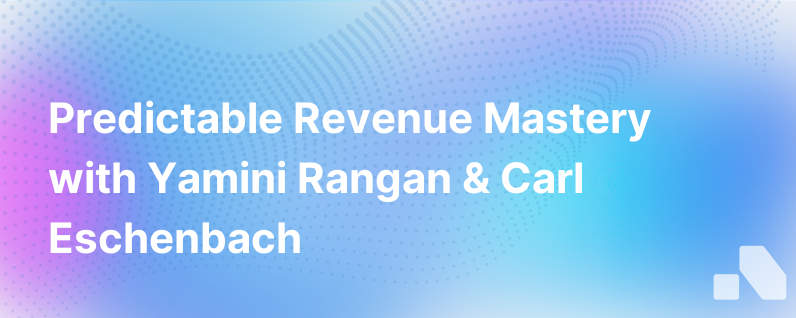
In the increasingly complex and competitive world of B2B sales, the quest for ‘predictable revenue’ is the Holy Grail for sales organizations. The term, popularized by Aaron Ross in his seminal book, denotes the ability to forecast and generate steady revenue growth—a feat akin to finding a dependable stream of water in the desert of business unpredictability.
Two contemporary thought leaders, Yamini Rangan, CEO of HubSpot, and Carl Eschenbach, Partner at Sequoia Capital and former President and COO of VMware, have made contributions to this conversation by articulating frameworks and mindsets for business leaders to deliver predictable revenue growth. Let’s explore their approaches, synthesize their insights, and build an understanding of how predictable revenue can be a reality rather than a wishful metric.
Understanding Predictable Revenue
Predictable revenue is built upon the foundation of well-structured recurring revenue models and consistent sales performances that meet or exceed growth benchmarks. It's more than knowing how much money you’ll make—it's about understanding your customers, market dynamics, sales process, and scaling operations to ensure stability and growth in revenue streams.
Yamini Rangan's Approach
Rangan operates at the nexus of customer success and seamless operation. Her approach is rooted in a deep understanding of customer needs and a firm belief in the power of inbound marketing and service-driven sales. A core tenet of her philosophy is the alignment of marketing, sales, and customer service to create a unified, frictionless experience.
Key strategies from Rangan include:
-
Leverage Data: Bring together disparate datasets to gain holistic insights into customer behaviors and preferences.
-
Customer-Centric Approach: Build your sales process around the customer buying journey. Address their pain points and help them accomplish their goals.
-
Use Scalable Systems: Implement technology solutions that can grow with your business. HubSpot, for example, emphasizes scalable CRM systems that centralize data and processes.
-
Enable Sales and Marketing Synergy: Align marketing efforts with sales objectives to create a consistent funnel that lead to qualified sales opportunities.
-
Continual Learning and Adaptation: Stay responsive to market trends and new customer insights to tailor your approach and maintain a growth mindset.
Carl Eschenbach’s Perspective
Eschenbach’s experience with enterprise sales and venture capital investments gives him a unique take on predictable revenue. He emphasizes building a culture that prizes discipline, accountability, and excellence at each stage of customer acquisition and expansion.
Essential elements from Eschenbach's philosophy:
-
Methodical Go-to-Market Strategy: Focus on go-to-market strategies that have clear KPIs, targeted customer segmentation, and value-prop messaging.
-
Invest in Talent: Attract, train, and retain top-tier sales professionals who can execute your sales process and understand complex buyer landscapes.
-
Metric-Driven Management: Depend on sales metrics and dashboards that track every aspect of the funnel, from lead generation to customer retention.
-
Sales and Operation Alignment: Ensure your sales strategies are supported by robust operations and infrastructure to deliver on promises made to the customer.
-
Long-Term Vision: Focus on building customer relationships for the long haul, not just one-off wins. This means investing in customer success and account management.
Synthesizing Insights and Strategies
Combining the insights of both Rangan and Eschenbach, we see that predictable revenue emerges at the intersection of great people, processes, and technology, all interwoven with a relentless focus on the customer. Now let’s operationalize these insights into a framework.
Building a Framework for Predictable Revenue
-
Customer Insight and Segmentation: Develop a deep understanding of your customers and segment them based on needs, behaviors, and potential. Both leaders stress the importance of using data to augment this understanding.
-
Align Teams Around the Customer: Break down silos between departments. Sales, marketing, and customer service should all work from the same playbook—the customer-centric playbook Rangan advocates for.
-
Invest in Your Sales Force: As Eschenbach noted, investing in training and retaining skilled sales professionals is crucial. Equip them with the knowledge and tools to provide value to prospects and customers.
-
Robust, Scalable Technology: Utilize a CRM system that grows with your company, allowing your team to track, analyze, and leverage customer data effectively.
-
Disciplined Execution: Create a culture of accountability where metrics are not just displayed but are dissected and acted upon. Eschenbach's disciplined approach ensures that the revenue pipeline is scrutinized and optimized.
-
Continuous Improvement: As the market evolves, so should your strategy. Invest in innovation and continuous improvement to keep your offerings and strategies fresh.
-
Focus on Lifetime Value: Eschew short-term gains for long-term relationships. Look at lifetime customer value as a core revenue metric, as it encourages a sustained commitment to customer success.
-
Iterative Go-to-Market Plan: Stay agile with your GTM strategy, iterating based on real-time feedback and results. This allows for on-the-fly adjustments, higher efficiency, and reduced waste of resources.
Conclusion
Predictable revenue isn't a silver bullet; it's the product of a well-engineered system that’s customer-centric, data-driven, and requires discipline to build and maintain. By drawing on the wisdom of leaders like Rangan and Eschenbach, businesses can construct their revenue machines to be both resilient and flexible, delivering predictability and peace of mind.
Aomni complements this entire process by offering real-time account research, competitive insights, and sales enablement material—further refining and simplifying the sales process for maximized outcomes and predictable revenue. By incorporating modern tools and thought leadership, the path to predictable revenue becomes less enigmatic and more of a structured journey towards organizational maturity and market success.